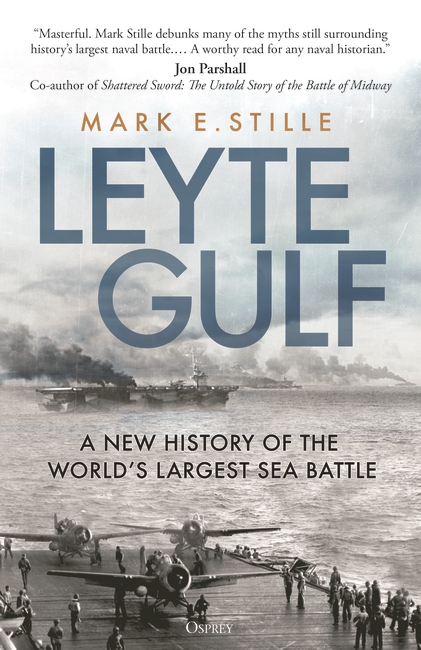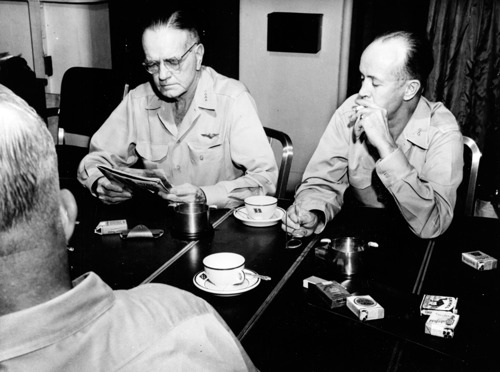
The Battle of Leyte Gulf has no counterpart. It remains the largest and most complex naval battle in history. To this day, it is the last battle between fleets. Two American fleets were involved. Vice Admiral Thomas Kinkaid’s Seventh Fleet was comprised of 738 ships and carried an invasion force of approximately 165,000 men, in addition to the 50,000 sailors aboard the ships. The other fleet, the Third under Admiral William Halsey, was the most powerful on the planet, with a total of 16 aircraft carriers and six of the world’s most advanced battleships. In total, the two fleets brought 235 surface combatants and 1,500 aircraft to the battle. Opposed to this naval might was the Imperial Japanese Navy. Once the greatest navy in the Pacific, the Imperial fleet was forced into a desperate fight that would require all its remaining strength. In total, the Japanese committed 69 ships and around 375 aircraft, most of which were land-based.

Admiral William Halsey, shown on the left, was the commander of the Third Fleet. Charged with providing cover for the Leyte invasion against the Imperial Navy, he acted in his usual aggressive manner to make a decision that has been criticized ever since.
Image credit: Naval History and Heritage Command
Instead of being a single battle as the name implies, Leyte Gulf was actually comprised of four major engagements and several lesser actions fought over the span of three days. The characteristics of the battle continue to astound – it contained the largest air-sea battle in history; it included the last carrier and battleship clashes in history; it marked the only time that a surface force engaged a carrier force while under air attack; and it featured the first pre-planned use of suicide attacks during the Pacific War.
It was a battle shaped by errors on both sides. The overarching mistake of the Americans was their divided command structure. Incredibly, the two US fleets engaged did not a have a direct and secure means of communicating with each other. The bifurcated command structure and a general lack of awareness of what each fleet was doing led to Halsey’s controversial decision and prevented the Americans from bringing their full power to bear. While Halsey’s missteps are the focus of most accounts, those made by Kinkaid were also important and deserve additional scrutiny.
The biggest mistake of all was the ill-conceived Japanese plan named Sho-Go (Victory Plan), devised by Admiral Toyoda Soemu. He admitted after the war that his plan went against accepted wisdom, but he felt he had to commit the Combined Fleet before it became irrelevant. In fact, with so little chance that his plan would achieve a strategic result and so high of a probability that the Combined Fleet would be destroyed during its execution, Toyoda should not have accepted battle under the conditions prevailing in October 1944. The Imperial Navy admitted to the Imperial Army that the plan was an “all-or-nothing” operation. The basis for the planning of Sho-Go was complete and utter desperation – not the best ingredient for success.

Admiral Toyoda Soemu was the author of the Japanese plan to defend the Philippines.
Image credit: Naval History and Heritage Command
Predictably, the operation resulted in a total debacle. The Japanese failed to stop the invasion of Leyte, slow the pace of the American advance in the Pacific, or inflict severe losses on the American fleet. Toyoda intended the battle to turn the tide of war in favor of Japan. Instead, it resulted in a categorical defeat for the Imperial Navy. Over the span of four days, the Japanese lost 28 ships comprising over 300,000 tons. The scale of these losses is unparalleled in naval history. Inasmuch as it resulted in the end of the Imperial Navy as an effective force, the battle was decisive. For the remainder of the war, the Americans had no real concerns about the ability of the Imperial Navy’s surface fleet to shape events. But Toyoda achieved his aim of providing the Combined Fleet with an opportunity to die fighting.
Even though Sho-Go had no prospect of success, and the battle resulted in an undisputed victory for the Americans, there is still controversy attached to it. Almost 80 years after the event, the myths created around the battle continue to gain strength. Providing cover for the enduring mythology are the two key decisions of the battle. The first was Halsey’s resolution to take his entire Third Fleet to the north to attack a Japanese decoy force. This clever diversionary aspect of Sho-Go has been viewed as though it provided the Japanese with victory or at least the foundation of victory. It did no such thing, but it did provide Vice Admiral Kurita Takeo with the opportunity to exploit the divided American command structure and enter the Philippine Sea with his powerful force of surface ships unchecked. Once there, he fell upon a group of American escort carriers known as Taffy 3. In the resulting Battle off Samar, the Americans sustained heavy losses but denied the Japanese an immediate victory. This led directly to the second key controversy of the battle when Kurita failed to press his attack to destroy Taffy 3 and then steam into Leyte Gulf, as had been Toyoda’s plan.
Since the most alluring aspects of the battle are bound up in its mythology, this book focuses on the myths of Leyte Gulf. The first surrounds the Japanese plan. Even in October 1944, Japan thought it could fight and win a decisive battle. In actuality, the Japanese had no chance to reverse the tide of war. Sho-Go was not a serious plan for victory but rather a vehicle to allow the Combined Fleet an honorable death. As framed, the variant of Sho-Go used to defend the Philippines (Sho-1) had no strategic purpose since it was literally impossible for the Combined Fleet to defeat the invasion before it was firmly established on Leyte. Even if the large force under Kurita had successfully attacked into the gulf as planned on 25 October, it had no chance to generate any strategic impact.
The second myth seems to be the one held most firmly. Any discussion of how American naval commanders performed at Leyte Gulf begins with Halsey. Most accounts of the battle make him the scapegoat for a lost American victory or even an American defeat. This is curious since Leyte Gulf was the greatest American naval victory of the war. Halsey’s controversial decisions often overshadow that fact. In trying to assess Halsey’s performance, two key decisions are held up for examination – his choice to go north late on 24 October and his determination to bring his battleships and a carrier task force back south late in the morning of 25 October. These certainly were pivotal moves that shaped the battle. However, focusing solely on them overlooks the bigger issue of Halsey’s handling of the Third Fleet. Even more damning than any shortcomings in the two decisions mentioned above is the fact that, during the entire period of the battle, the full power of the Third Fleet was never brought to bear at any time.
Accepted wisdom is that Halsey acted stupidly on the night of 24 October when he decided to take the entire Third Fleet north to attack the Japanese carrier force acting as a decoy. The author believes Halsey acted correctly with the information he had available at the time. In fact, his decision was virtually pre-ordained. Given his mindset, his orders, existing US Navy doctrine, and the manner in which the battle developed, there was no chance of him acting differently. Criticism of Halsey’s actions is extremely easy with the benefit of hindsight, but such judgment is built on knowledge that he could not have possessed in the moment.
This is not to say that Halsey should be forgiven for his faults. Everything he did was magnified since he commanded the most powerful naval force in the world during history’s largest naval battle. Even if he is excused for taking the bait so cleverly presented by the Japanese, his other actions before and after this decision were poor. As is detailed in this account, Halsey failed to bring his full power against either of the two main Japanese forces engaged. This denied him the battle of annihilation he so earnestly desired.

Vice Admiral Kurita Takeo was the most controversial Japanese commander of the battle.
Image credit: Naval History and Heritage Command
The hardest myth to displace is the notion that Kurita’s force should have utterly annihilated Taffy 3 at the Battle off Samar. In the accepted version of events, the underdog American force prevailed against overwhelming odds. Unparalleled American bravery provided the edge while the Japanese blundered their way to defeat. There is no doubt that the bravery of American sailors played a prominent role in the battle, but it was not just a David and Goliath contest with American destroyers attacking Japanese battleships. The battle was unlike any other fought in naval history. A force of heavy ships surprised and attacked a carrier force during daylight and fought a prolonged surface battle while under persistent air attack. The Battle off Samar was not just a surface engagement, it was an air-sea battle of immense proportions. In addition to the brave and much-heralded attacks by the escorting destroyers, the Americans brought over 200 aircraft into play. The primary American weapon was aircraft, not the heroic escorting destroyers and destroyer escorts. The fact that a large force of aircraft defeated a surface force should be no surprise. That was the established norm from the very first day of the Pacific War.
The next myth is one that is hardly even examined. It is generally assumed that Kurita led poorly by not pressing into the gulf when he had the chance and that, by declining to do so, he threw away victory. On the contrary, Kurita carefully considered his options and acted out of conscience by deciding not to throw away the lives of his men. He realized the utter futility of Sho-1. Because it offered no prospect of success, Kurita was totally justified to reject its suicidal design. As is detailed in this account, Kurita correctly discerned there was nothing to gain to by following his orders to a dramatic but futile finish. Even Imperial Navy officers had a limit to their willingness to sacrifice thousands of men for no purpose.
The last myth is directly tied to Kurita’s refusal to commit his force to a such a fate. As prevailing wisdom goes, had he only pressed his attack, Kurita would have found nothing in his way and, once inside the gulf, claimed targets of such importance that their destruction would have changed the course of the American campaign to retake the Philippines or even of the war itself. Few myths are easier to refute. Kurita would have faced a force larger than his own, supported by hundreds of aircraft, even before he could have entered the gulf. Moreover, if he had, by chance, successfully forced his way into the gulf, there were few ships of value there to attack (with the exception of the three command ships and the cruiser that General Douglas MacArthur was embarked on). The invasion force was long gone, but there were 28 Liberty ships and 23 landing ship tanks (LSTs) remaining. Even in the extremely unlikely event that all had been sunk, their loss would have made no difference to the Philippines campaign or the pace of the American advance in the final months of the war. A nation that could build over 2,700 Liberty ships and over 1,000 LSTs would shrug off such losses.
This book asks readers to take a fresh look at the Battle of Leyte Gulf, overturning decades of faulty analysis based on incorrect assumptions.

Comments
You must be logged in to comment on this post. Click here to log in.
Submit your comment